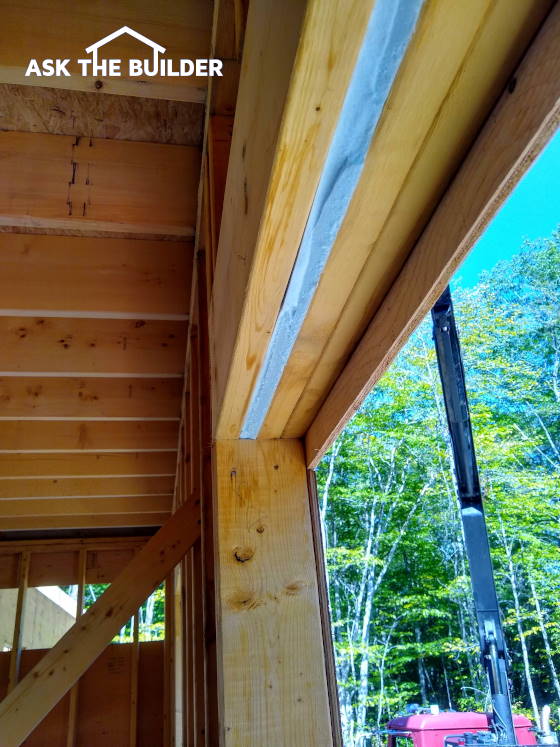Foam Insulation Above Windows & Painting Bath Tile

Foam Insulation Above Windows | This is a beam across the top of a window. It should have had twice as much closed-cell foam insulation. (C) Copyright 2019 Tim Carter
Foam Insulation Above Windows
QUESTION #1: Tim, I need your expert opinion. I’m building a new home with 2x6 exterior walls. Beams have to be installed over the top of all windows and doors. What’s a great way to insulate these as the solid wood creating the beam doesn’t have a very high R-value. What did you used to do and did you ever have any failures? Beth S., Table Rock, WY
You may be building a new home or contemplating a room addition like Beth. If so, you’ve got a once-in-a-lifetime opportunity to make your home as energy-efficient as possible. It’s important to realize that once the wall framing is covered with exterior siding, brick or stone and the inside is covered with drywall, paneling, or plaster, it’s impractical to tear everything apart to add more insulation over a window or door.
The issue of beams, or headers, over windows and doors is somewhat complex. The size and number of the framing members used to create the beam depends on the load that’s pressing down on top of the window or door. This load can be small or it can be enormous.
The last home I built for my family had a header over an opening that had a concentrated load on it that was the sum of 1/4 the load of the entire second floor, plus 1/4th of the attic floor, plus a large part of the roof. One end of a large beam carrying all that load was resting on the header, or beam, that spanned over the opening.
You want the smallest beam height as you can get by with that will handle the load as calculated by a residential structural engineer. These professionals almost always include an additional safety factor. If you oversize the beam to a great degree, you simply have too much solid wood where there could be a full-thickness fiberglass batt or spray foam depending on what you’ll use for your wall insulation.
For example, a small narrow window in a wall that has no concentrated loads above it may have a header beam that’s just made with one or two 2x6s and the rest of the space can be filled with closed-cell foam insulation.
The wider the window or door opening the taller the wood beam must be to handle the load above the space. Engineers will tell you if the beam needs to be made from something as large as multiple 2x12s.
I’ve installed countless header beams across windows and doors and never had any failures. I never used more than a double 2x12 in the largest openings. In rare cases, the engineer or architect called for a metal flitch plate that was bolted to the inside of the wood header. The steel added an extreme amount of strength to the beam.
Closed-cell foam is a great material because it also acts as a very good vapor retarder. The foam comes in various thicknesses so you can fill the space in the header completely with foam depending on how much wood the engineer or architect specifies.
Painting Bath Tile
QUESTION #2: Dad, what can I do to make the tile in my apartment bath and shower look better? I just want to paint the dingy tan tile all white. Should I coat the paint with a clear coating for durability? What problems might I have? Your loving daughter, Kelly
Yes, my daughter texted me that question last night. She lives in Puerto Rico and at least had the good sense to ask me what to do before creating a nightmare.
Painting tile can be very problematic. It’s important to realize that paint is just colored glue. Most consumer paints prefer to stick to rougher surfaces like drywall and wood, not glass. The surface of almost all ceramic tile has an ultra-thin top layer of glaze or glass. That’s why most ceramic tile has a gloss to it.
The internet is littered with stories from homeowners who paid companies to come out and *re-glaze* their porcelain or cast-iron bathtubs. These tubs have the same ceramic glaze on them as tile. If you truly want to re-glaze a tub, you need to rip it out and send it back into a kiln.
The companies don’t re-glaze the tub. They paint the tub with special epoxy paint. Go read the stories about how some of these installations fail and the paint peels. It’s all about adhesion, never forget that.
The paint, and even a clear coating you might use to protect the paint, generally are not as hard as the glaze on tile. This means that they can be scratched with ease and cleaning with any abrasive cleanser will absolutely dull the painted finish.
Water is the biggest culprit and painted tile in a shower stall will almost always fail in short order. I’ve successfully painted wall tile that doesn’t get wet. You can paint floor tile in a room and coat it with three coats of water-based clear urethane. The urethane protecting the paint is the same product used to protect hardwood floors. Once again, this will work well as long as you don’t subject the painted floor tile to lots of water.
Column 1320